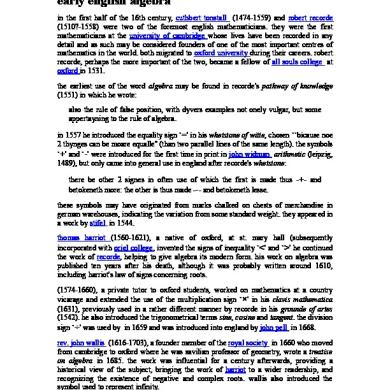Math Early English
This document was uploaded by user and they confirmed that they have the permission to share it. If you are author or own the copyright of this book, please report to us by using this DMCA report form. Report DMCA
Overview
Download & View Math Early English as PDF for free.
More details
- Words: 459
- Pages: 1
early english algebra in the first half of the 16th century, cuthbert tonstall (1474-1559) and robert recorde (1510?-1558) were two of the foremost english mathematicians. they were the first mathematicians at the university of cambridge whose lives have been recorded in any detail and as such may be considered founders of one of the most important centres of mathematics in the world. both migrated to oxford university during their careers. robert recorde, perhaps the more important of the two, became a fellow of all souls college at oxford in 1531. the earliest use of the word algebra may be found in recorde's pathway of knowledge (1551) in which he wrote: also the rule of false position, with dyvers examples not onely vulgar, but some appertayning to the rule of algebra. in 1557 he introduced the equality sign `=' in his whetstone of witte, chosen ``bicause noe 2 thynges can be moare equalle'' (than two parallel lines of the same length). the symbols `+' and `-' were introduced for the first time in print in john widman arithmetic (leipzig, 1489), but only came into general use in england after recorde's whetstone: there be other 2 signes in often use of which the first is made thus - +- and betokeneth more: the other is thus made --- and betokeneth lesse. these symbols may have originated from marks chalked on chests of merchandise in german warehouses, indicating the variation from some standard weight. they appeared in a work by stifel in 1544. thomas harriot (1560-1621), a native of oxford, at st. mary hall (subsequently incorporated with oriel college, invented the signs of inequality `<' and `>' he continued the work of recorde, helping to give algebra its modern form. his work on algebra was published ten years after his death, although it was probably written around 1610, including harriot's law of signs concerning roots. (1574-1660), a private tutor to oxford students, worked on mathematics at a country vicarage and extended the use of the multiplication sign `×' in his clavis mathematica (1631), previously used in a rather different manner by recorde in his grounde of artes (1542). he also introduced the trigonometrical terms sine, cosine and tangent. the division sign `÷' was used by in 1659 and was introduced into england by john pell in 1668. rev. john wallis (1616-1703), a founder member of the royal society in 1660 who moved from cambridge to oxford where he was savilian professor of geometry, wrote a treatise on algebra in 1685. the work was influential for a century afterwards, providing a historical view of the subject, bringing the work of harriot to a wider readership, and recognizing the existence of negative and complex roots. wallis also introduced the symbol used to represent infinity.
Related Documents

Math Early English
November 2019 20
Review - Early Modern English Drama
August 2019 21
English Sounds Worth Stressing Early
December 2019 35
Math
July 2020 92
Math
July 2020 106